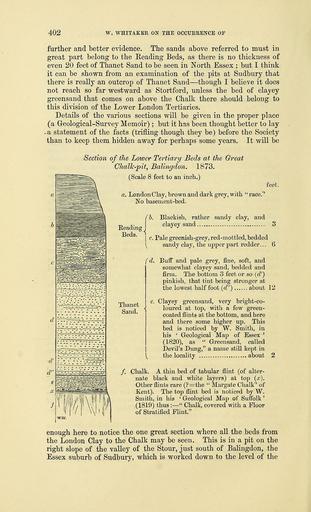MAKE A MEME
View Large Image

| View Original: | The_Quarterly_journal_of_the_Geological_Society_of_London_(12733864315).jpg (1945x3200) | |||
| Download: | Original | Medium | Small | Thumb |
| Courtesy of: | commons.wikimedia.org | More Like This | ||
| Keywords: The Quarterly journal of the Geological Society of London (12733864315).jpg THAKET BEDS AND CRAG AT ST7DBURY SUEEOLK 403 <br> river laying bare the set of beds shown in the figure drawn on the <br> same scale as various analogous figures in the Memoir on the <br> London Basin <br> No fossils have been found in the beds that I have classed as <br> Thanet Sand except some pieces of Foraminifera by Dr Holden ; <br> the reasons for this classification are purely lithological and as <br> follows ” <br> 1 The likeness of the sand in fineness compactness and colour <br> to that which occurs in the same position in West Kent <br> 2 The persistence of these characters in all the sections and the <br> absence of false-bedding of pebbles and of red-mottling tending to <br> show that the sand belongs to tbe Thanet Beds rather than to the <br> more varying Reading Series <br> 3 The fact that the greensand at the bottom is like the base- <br> bed of the Thanet Sand ; and the occurrence immediately beneath <br> it of a layer of tabular flint as is very usual where that bed caps <br> the Chalk <br> Westward from Sudbury I have traced this sand for more than <br> three miles ; but eastward it is soon hidden by Drift after being <br> shown in many sections on the outskirts of the town The green- <br> sand over the Chalk near Ipswich is much like that at Sudbury ; <br> so perhaps the progress of the Geological Survey may establish the <br> occurrence of the Thanet Beds in that direction <br> In the northern band here noticed this division seems to be pre- <br> sent at the expense of the overlying Beading Beds which are re- <br> markably thin at Sudbury; and this outcrop most likely joins on <br> underground to that in South Essex and Kent many of the deep wells <br> in the tract between seeming to pass through the Thanet Sand <br> 2 Crag <br> The pits that give evidence of the occurrence of Crag have been <br> opened only during the last few years and are all on the left or <br> Suffolk side of the Stour at the northern and eastern edge of Sud- <br> bury the three best sections being close together on the hill within <br> a quarter of a mile N E of St Peter's Church <br> The general section of these is as follows ” <br> A small patch of Drift <br> Crag Ferruginous dark reddish -brown sand -with layers of ironstone slightly <br> false-bedded ; in parts a light-coloured grit with broken shells ; <br> thin layers of flint-pebbles phosphatic nodules and phosphatized <br> bones in the lower part ; and at the bottom a marked bed of the same <br> up to a foot or more thick The whole as much as 10 feet in a hol- <br> low elsewhere as much as 7 feet <br> Thanet Sand ; the lower pinkish bed and the green base-bed <br> Chalk <br> In the furthest pit Mr Webb's the shells are mostly broken up <br> and many specimens of Purpura lapillus var crispata with one <br> valve of a small Anomia ephijppiurn were all that could be found in <br> any thing like a perfect state ; but in the nearest pit Mr Harding's <br> Memoirs of the Geological Survey iv 1872 35766312 110599 51125 Page 402 Text v 30 http //www biodiversitylibrary org/page/35766312 1874 Geological Society of London NameFound Foraminifera NameConfirmed Foraminifera EOLID 2869058 NameBankID 5953016 NameFound Purpura lapillus NameConfirmed Purpura lapillus EOLID 4833585 NameBankID 6359643 Biodiversity Heritage Library The Quarterly journal of the Geological Society of London v 30 1874 Geology Periodicals Smithsonian Libraries bhl page 35766312 dc identifier http //biodiversitylibrary org/page/35766312 smithsonian libraries Information field Flickr posted date ISOdate 2014-02-24 Check categories 2015 August 26 CC-BY-2 0 BioDivLibrary https //flickr com/photos/61021753 N02/12733864315 2015-08-26 20 03 35 cc-by-2 0 PD-old-70-1923 The Quarterly journal of the Geological Society of London 1874 Photos uploaded from Flickr by Fæ using a script | ||||